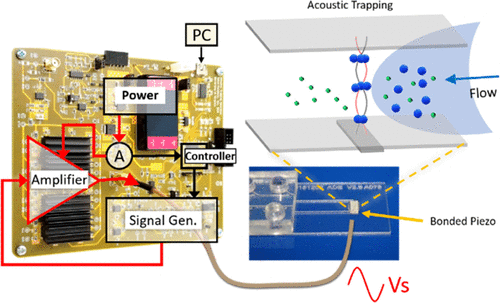Our official English website, www.x-mol.net, welcomes your
feedback! (Note: you will need to create a separate account there.)
Real-Time Detection and Control of Microchannel Resonance Frequency in Acoustic Trapping Systems by Monitoring Amplifier Supply Currents
ACS Sensors ( IF 8.2 ) Pub Date : 2021-09-29 , DOI: 10.1021/acssensors.1c01580 Vahid Farmehini 1 , Sadie Kiendzior 2 , James P Landers 2 , Nathan S Swami 1, 2
ACS Sensors ( IF 8.2 ) Pub Date : 2021-09-29 , DOI: 10.1021/acssensors.1c01580 Vahid Farmehini 1 , Sadie Kiendzior 2 , James P Landers 2 , Nathan S Swami 1, 2
Affiliation

|
The utilization of bulk acoustic waves from a piezoelectric transducer for selective particle trapping under flow in a microchannel is limited by the high sensitivity of the resonance frequency to tolerances in device geometry, drift during trapping, and variations in the local flow or sample conditions in each channel. This is addressed by detecting the resonance condition based on the impedance minimum obtained by monitoring the amplitude of the stimulation voltage across the piezo transducer and utilizing real-time feedback to control the stimulation frequency. However, this requires an overlap in the frequency bandwidth of the detection and the stimulation system and is also limited by the decline in the acoustic trapping power when the stimulation and resonance frequency measurement are conducted simultaneously. Instead, we present a novel circuit implementation for on-chip real-time resonance frequency measurement and feedback control based on monitoring the current drawn from the amplifier used to stimulate the piezo transducer, since the need for high measurement sensitivity in this mode does not lower the power available for stimulation of the transducer. The enhanced level of control of acoustic trapping utilizing this current mode is validated for various localized channel perturbations, including drift, wash steps, and buffer swaps, as well as for selective sperm cell trapping from a heterogeneous sample that includes lysed epithelial cells.
中文翻译:

通过监测放大器电源电流实时检测和控制声波捕获系统中的微通道谐振频率
利用来自压电换能器的体声波在微通道中的流动下选择性捕获粒子受到共振频率对器件几何公差的高灵敏度、捕获过程中的漂移以及局部流动或样品条件变化的限制。渠道。这是通过基于通过监测压电换能器两端的刺激电压的幅度获得的阻抗最小值检测共振条件并利用实时反馈来控制刺激频率来解决的。然而,这需要检测和刺激系统的频率带宽重叠,并且当刺激和共振频率测量同时进行时,还受到声捕获功率下降的限制。反而,我们提出了一种用于片上实时谐振频率测量和反馈控制的新型电路实现,它基于监控从用于激励压电换能器的放大器汲取的电流,因为在这种模式下需要高测量灵敏度并不会降低功率可用于刺激换能器。利用此电流模式增强的声学捕获控制水平已针对各种局部通道扰动进行了验证,包括漂移、洗涤步骤和缓冲液交换,以及从包括裂解的上皮细胞的异质样本中选择性捕获精子细胞。因为在此模式下需要高测量灵敏度并不会降低可用于刺激换能器的功率。利用此电流模式增强的声学捕获控制水平已针对各种局部通道扰动进行了验证,包括漂移、洗涤步骤和缓冲液交换,以及从包括裂解的上皮细胞的异质样本中选择性捕获精子细胞。因为在此模式下需要高测量灵敏度并不会降低可用于刺激换能器的功率。利用此电流模式增强的声学捕获控制水平已针对各种局部通道扰动进行了验证,包括漂移、洗涤步骤和缓冲液交换,以及从包括裂解的上皮细胞的异质样本中选择性捕获精子细胞。
更新日期:2021-10-22
中文翻译:

通过监测放大器电源电流实时检测和控制声波捕获系统中的微通道谐振频率
利用来自压电换能器的体声波在微通道中的流动下选择性捕获粒子受到共振频率对器件几何公差的高灵敏度、捕获过程中的漂移以及局部流动或样品条件变化的限制。渠道。这是通过基于通过监测压电换能器两端的刺激电压的幅度获得的阻抗最小值检测共振条件并利用实时反馈来控制刺激频率来解决的。然而,这需要检测和刺激系统的频率带宽重叠,并且当刺激和共振频率测量同时进行时,还受到声捕获功率下降的限制。反而,我们提出了一种用于片上实时谐振频率测量和反馈控制的新型电路实现,它基于监控从用于激励压电换能器的放大器汲取的电流,因为在这种模式下需要高测量灵敏度并不会降低功率可用于刺激换能器。利用此电流模式增强的声学捕获控制水平已针对各种局部通道扰动进行了验证,包括漂移、洗涤步骤和缓冲液交换,以及从包括裂解的上皮细胞的异质样本中选择性捕获精子细胞。因为在此模式下需要高测量灵敏度并不会降低可用于刺激换能器的功率。利用此电流模式增强的声学捕获控制水平已针对各种局部通道扰动进行了验证,包括漂移、洗涤步骤和缓冲液交换,以及从包括裂解的上皮细胞的异质样本中选择性捕获精子细胞。因为在此模式下需要高测量灵敏度并不会降低可用于刺激换能器的功率。利用此电流模式增强的声学捕获控制水平已针对各种局部通道扰动进行了验证,包括漂移、洗涤步骤和缓冲液交换,以及从包括裂解的上皮细胞的异质样本中选择性捕获精子细胞。











































 京公网安备 11010802027423号
京公网安备 11010802027423号